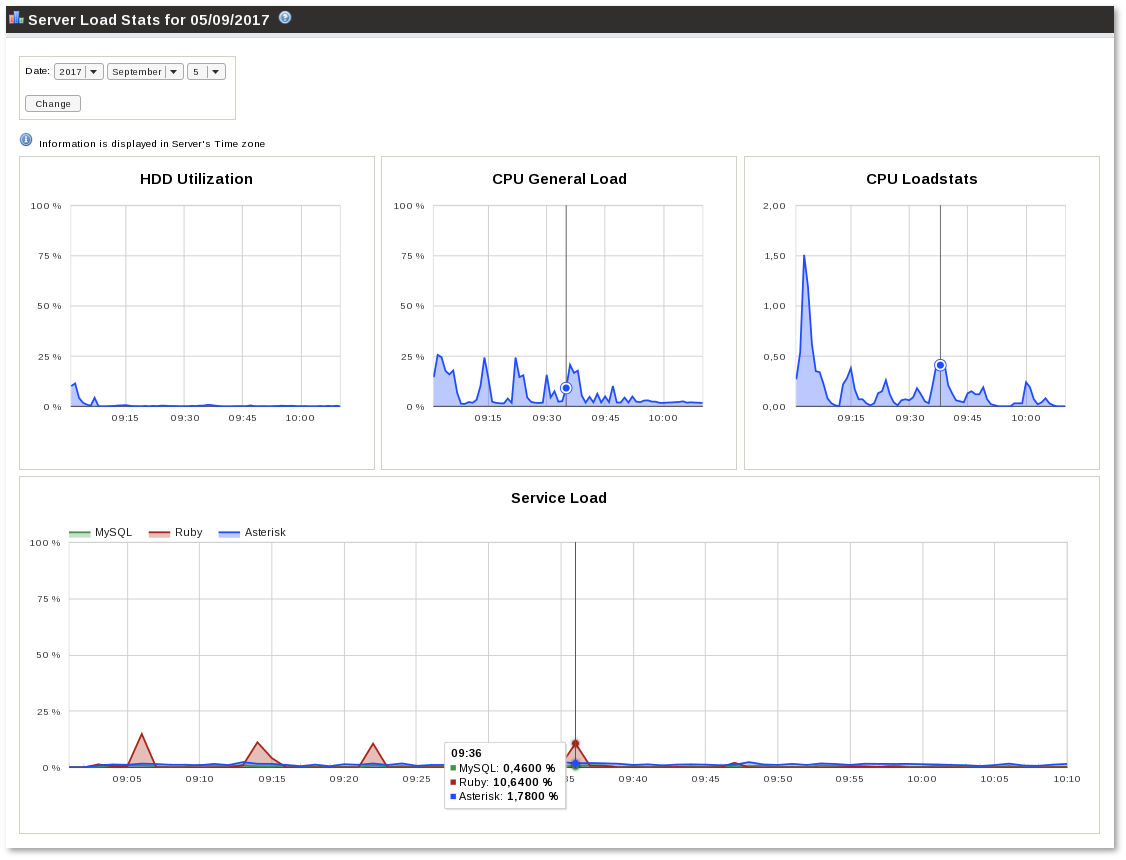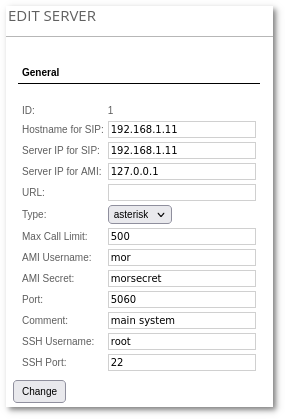Difference between revisions of "Multi Server support"
| (44 intermediate revisions by 10 users not shown) | |||
| Line 1: | Line 1: | ||
''This functionality is available from MOR 0.7'' | <br><br> | ||
<!--- ''This functionality is available from MOR 0.7''. --> | |||
=What is Multi Server support?= | |||
With this system, it is possible to manage several Asterisk servers from GUI. | |||
These servers are Asterisk servers which work with calls and BILL them. | |||
<br><br> | |||
== How to make calls from devices on different Asterisk server == | |||
1. Create 2 devices, device A and device B. | |||
2. Mark the correct Asterisk server in [[Device_settings | settings]] for those devices. | |||
3. Create 2 DID numbers (any number format you need/want) DID1 and DID2 | |||
4. Forward DID to device (Assign DID to user and forward it to device) DID1 to device A, DID2 to device B | |||
5. Register devices to the Asterisk servers that they belong | |||
6. Call from Device A to DID2 to reach Device B, and vice versa. | |||
<br><br> | |||
= [[Providers]] = | |||
==Where to find [[Providers | providers]] of a specific Asterisk server?== | |||
1. Go to Severs | |||
2. To get to [[Providers | providers]] list of a specific Asterisk server press the marked icon: | |||
[[File:Asterisk_servers_providers_list_new.png]] | |||
This window shows which [[Providers]] are accessible from '''this Server'''. | |||
<br><br> | |||
[[File:Asterisk_servers_providers_list.png]] | |||
<br><br> | |||
=Call Flows= | |||
Lets say we have: | |||
Provider provA and Device devA configured on Asterisk server ast1; | |||
Provider provB and Device devB configured on Asterisk server ast2; | |||
Provider provC configured on both Asterisk servers (ast1 and ast2). | |||
Possible call flows are: | |||
devA makes call through provA (user > ast1 > provA); | |||
devB makes call through provB (user > ast2 > provider); | |||
devA makes call through provB (user > ast1 > ast2 > provB); | |||
devB makes call through provA (user > ast2 > ast1 > provA); | |||
devA makes call through provC (user > ast1 > provC); | |||
devB makes call through provC (user > ast2 > provC). | |||
<br><br> | <br><br> | ||
- | = Server Version/Uptime = | ||
Available from MOR 12 - These values are updated automatically by MOR. Not possible to change them manually. | |||
<br><br> | <br><br> | ||
= | =Stats= | ||
Available from MOR x4: | |||
==Where to find server statistics== | |||
1. Go to Severs | |||
Column "Free space" indicates how much free space is left on server's hard drive. | |||
2. To get to stats of a specific server press the marked icon: | |||
[[File:server_3.png]] | |||
==Graphs== | |||
*HDD Utilization - shows current hard drive utilization. | |||
*CPU General Load - the general load of CPU. | |||
*CPU Loadstats - CPU load statistics. | |||
*Service Load - load caused by MySQL, Ruby and Asterisk. | |||
<br> | |||
[[File:servers_stats_view.png]] | |||
<br><br> | |||
=Edit server= | |||
[[File:Edit_server_servers.png]] | |||
'''ID''' - server's ID number.<br> | |||
'''Hostname for SIP''' - hostname or IP address for SIP. Required.<br> | |||
'''Server IP for SIP''' - IP address for SIP. Required.<br> | |||
'''Server IP for AMI''' - IP address for Asterisk Manager Interface. Required.<br> | |||
'''URL''' - for informational purposes.<br> | |||
'''Type''' - Asterisk or Other.<br> | |||
'''Max Call Limit''' - for informational purposes.<br> | |||
'''AMI Username''' - username for Asterisk Manager Interface. Required.<br> | |||
'''AMI Secret''' - password for Asterisk Manager Interface. Required.<br> | |||
'''Port''' - SIP port. Required.<br> | |||
'''Comment''' - for informational purposes.<br> | |||
'''SSH Username''' - default root. Required.<br> | |||
'''SSH Port''' - default 22. Required.<br> | |||
<br><br> | |||
=Additional Notes= | |||
* Every Provider can belong to every Server. | |||
* It is important to map the correct Providers to the correct servers. | |||
* Database and GUI servers are not described here. | |||
* Free space value is not related with other stats values. | |||
<br><br> | |||
= See also = | |||
* [[Intelligent Internal Routing]] | |||
* [[Server is overloaded]] | |||
Latest revision as of 10:06, 5 January 2023
What is Multi Server support?
With this system, it is possible to manage several Asterisk servers from GUI.
These servers are Asterisk servers which work with calls and BILL them.
How to make calls from devices on different Asterisk server
1. Create 2 devices, device A and device B.
2. Mark the correct Asterisk server in settings for those devices.
3. Create 2 DID numbers (any number format you need/want) DID1 and DID2
4. Forward DID to device (Assign DID to user and forward it to device) DID1 to device A, DID2 to device B
5. Register devices to the Asterisk servers that they belong
6. Call from Device A to DID2 to reach Device B, and vice versa.
Providers
Where to find providers of a specific Asterisk server?
1. Go to Severs
2. To get to providers list of a specific Asterisk server press the marked icon:
This window shows which Providers are accessible from this Server.

Call Flows
Lets say we have:
Provider provA and Device devA configured on Asterisk server ast1;
Provider provB and Device devB configured on Asterisk server ast2;
Provider provC configured on both Asterisk servers (ast1 and ast2).
Possible call flows are:
devA makes call through provA (user > ast1 > provA);
devB makes call through provB (user > ast2 > provider);
devA makes call through provB (user > ast1 > ast2 > provB);
devB makes call through provA (user > ast2 > ast1 > provA);
devA makes call through provC (user > ast1 > provC);
devB makes call through provC (user > ast2 > provC).
Server Version/Uptime
Available from MOR 12 - These values are updated automatically by MOR. Not possible to change them manually.
Stats
Available from MOR x4:
Where to find server statistics
1. Go to Severs
Column "Free space" indicates how much free space is left on server's hard drive.
2. To get to stats of a specific server press the marked icon:
Graphs
- HDD Utilization - shows current hard drive utilization.
- CPU General Load - the general load of CPU.
- CPU Loadstats - CPU load statistics.
- Service Load - load caused by MySQL, Ruby and Asterisk.
Edit server
ID - server's ID number.
Hostname for SIP - hostname or IP address for SIP. Required.
Server IP for SIP - IP address for SIP. Required.
Server IP for AMI - IP address for Asterisk Manager Interface. Required.
URL - for informational purposes.
Type - Asterisk or Other.
Max Call Limit - for informational purposes.
AMI Username - username for Asterisk Manager Interface. Required.
AMI Secret - password for Asterisk Manager Interface. Required.
Port - SIP port. Required.
Comment - for informational purposes.
SSH Username - default root. Required.
SSH Port - default 22. Required.
Additional Notes
- Every Provider can belong to every Server.
- It is important to map the correct Providers to the correct servers.
- Database and GUI servers are not described here.
- Free space value is not related with other stats values.




